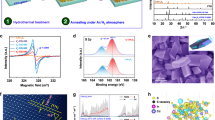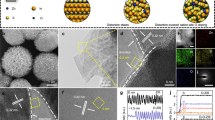Abstract
Oxysulfide semiconductors have narrow bandgaps suitable for water splitting under visible-light irradiation, because the electronegative sulfide ions negatively shift the valence band edges of the corresponding oxides1,2. However, the instability of sulfide ions during the water oxidation is a critical obstacle to simultaneous evolution of hydrogen and oxygen3. Here, we demonstrate the activation and stabilization of Y2Ti2O5S2, with a bandgap of 1.9 eV, as a photocatalyst for overall water splitting. On loading of IrO2 and Rh/Cr2O3 as oxygen and hydrogen evolution co-catalysts, respectively, and fine-tuning of the reaction conditions, simultaneous production of stoichiometric amounts of hydrogen and oxygen was achieved on Y2Ti2O5S2 during a 20 h reaction. The discovery of the overall water splitting capabilities of Y2Ti2O5S2 extends the range of promising materials for solar hydrogen production.
This is a preview of subscription content, access via your institution
Access options
Access Nature and 54 other Nature Portfolio journals
Get Nature+, our best-value online-access subscription
$29.99 / 30 days
cancel any time
Subscribe to this journal
Receive 12 print issues and online access
$259.00 per year
only $21.58 per issue
Buy this article
- Purchase on Springer Link
- Instant access to full article PDF
Prices may be subject to local taxes which are calculated during checkout





Similar content being viewed by others
Data availability
The data that support the findings of this study are available from the corresponding author upon reasonable request.
References
Ishikawa, A. et al. Oxysulfide Sm2Ti2S2O5 as a stable photocatalyst for water oxidation and reduction under visible light irradiation (λ ≤ 650 nm). J. Am. Chem. Soc. 124, 13547–13553 (2002).
Ishikawa, A. et al. Oxysulfides Ln2Ti2S2O5 as stable photocatalysts for water oxidation and reduction under visible-light irradiation. J. Phys. Chem. B 108, 2637–2642 (2004).
Fujito, H. et al. Layered perovskite oxychloride Bi4NbO8Cl: a stable visible light responsive photocatalyst for water splitting. J. Am. Chem. Soc. 138, 2082–2085 (2016).
Shaner, M. R., Atwater, H. A., Lewis, N. S. & McFarland, E. W. A comparative technoeconomic analysis of renewable hydrogen production using solar energy. Energy Environ. Sci. 9, 2354–2371 (2016).
Bala, C. R., Breen, S., Shao, Y., Ardo, S. & Weber, A. Z. Evaluating particle-suspension reactor designs for Z-scheme solar water splitting via transport and kinetic modeling. Energy Environ. Sci. 11, 115–135 (2018).
Goto, Y. et al. A particulate photocatalyst water-splitting panel for large-scale solar hydrogen generation. Joule 2, 509–520 (2018).
Sivula, K. & van de Krol, R. Semiconducting materials for photoelectrochemical energy conversion. Nat. Rev. Mater. 1, 15010 (2016).
Tachibana, Y., Vayssieres, L. & Durrant, J. R. Artificial photosynthesis for solar water-splitting. Nat. Photon. 6, 511–518 (2012).
Ellis, A. B., Kaiser, S. W., Bolts, J. M. & Wrighton, M. S. Study of n-type semiconducting cadmium chalcogenide-based photoelectrochemical cells employing polychalcogenide electrolytes. J. Am. Chem. Soc. 99, 2839–2848 (1977).
Wolff, C. M. et al. All-in-one visible-light-driven water splitting by combining nanoparticulate and molecular co-catalyst on CdS nanorods. Nat. Energy 3, 862–869 (2018).
Ran, J., Zhang, J., Yu, J., Jaroniec, M. & Qiao, S. Earth-abundant cocatalysts for semiconductor-based photocatalytic water splitting. Chem. Soc. Rev. 43, 7787–7812 (2014).
Denis, S. G. & Clarke, S. J. Two alternative products from the intercalation of alkali metals into cation-defective Ruddlesden–Popper oxysulfides. Chem. Commun. 22, 2356–2357 (2001).
Hyett, G. et al. Electronically driven structural distortions in lithium intercalates of the n = 2 Ruddlesden–Popper-type host Y2Ti2O5S2: synthesis, structure and properties of LixY2Ti2O5S2 (0 < x < 2). J. Am. Chem. Soc. 126, 1980–1991 (2004).
Kristin, P. Materials Data on Y 2Ti 2S 2O 5 (SG:139) by Materials Project (Lawrence Berkeley National Lab, 2016); https://doi.org/10.17188/1200585
Oki, H. & Takagi, H. Y2Ti2O5S2 as a high performance anode material for Li ion batteries. Solid State Ion. 276, 80–83 (2015).
Rutt, O. J., Hill, T. L., Gál, Z. A., Hayward, M. A. & Clarke, S. J. The cation-deficient Ruddlesden-Popper oxysulfide Y2Ti2O5S2 as a layered sulfide: topotactic potassium intercalation to form KY2Ti2O5S2. Inorg. Chem. 42, 7906–7911 (2003).
Ingo, G., Paparazzo, E., Bagnarelli, O. & Zacchetti, N. XPS studies on cerium, zirconium and yttrium valence states in plasma-sprayed coatings. Surf. Interface Anal. 16, 515–519 (1990).
BaQais, A. et al. Bismuth silver oxysulfide for photoconversion applications: structural and optoelectronic properties. Chem. Mater. 29, 8679–8689 (2017).
Maeda, K. et al. Noble-metal/Cr2O3 core/shell nanoparticles as a cocatalyst for photocatalytic overall water splitting. Angew. Chem. Int. Ed. 118, 7970–7973 (2006).
Gu., J. et al. Water reduction by a p-GaInP2 photoelectrode stabilized by an amorphous TiO2 coating and a molecular cobalt catalyst. Nat. Mater. 15, 456–460 (2016).
Vequizo, J. J. M., Hojamberdiev, M., Teshima, K. & Yamakata, A. Role of CoOx cocatalyst on Ta3N5 photocatalysts studied by transient visible to mid-infrared absorption spectroscopy. J. Photochem. Photobiol. C 358, 315–319 (2018).
Kato, H., Asakura, K. & Kudo, A. Highly efficient water splitting into H2 and O2 over lanthanum-doped NaTaO3 photocatalysts with high crystallinity and surface nanostructure. J. Am. Chem. Soc. 125, 3082–3089 (2013).
Sherkar, T. S. et al. Recombination in perovskite solar cells: significance of grain boundaries, interface traps and defections. ACS Energy Lett. 2, 1214–1222 (2017).
Inoue, Y. Photocatalytic water splitting by RuO2-loaded metal oxides and nitrides with d 0- and d 10-related electronic configurations. Energy Environ. Sci. 2, 364–386 (2009).
Kibria, M. G. et al. Visible light-driven efficient overall water splitting using p-type metal-nitride nanowire arrays. Nat. Commun. 6, 6797 (2015).
Lyu, H. et al. An Al-doped SrTiO3 photocatalyst maintaining sunlight-driven overall water splitting activity for over 1,000 h of constant illumination. Chem. Sci. 10, 3196–3201 (2019).
Milman, V. et al. Electronic structure, properties and phase stability of inorganic crystals: a pseudopotential plane-wave study. Int. J. Quantum Chem. 77, 895–910 (2000).
Materials Studio CASTEP (Accelrys, 2001).
Minegishi, T., Nishimura, N., Kubota, J. & Domen, K. Photoelectrochemical properties of LaTiO2N electrodes prepared by particle transfer for sunlight-driven water splitting. Chem. Sci. 4, 1120–1124 (2013).
Le, P.-T. C. et al. Photoelectrochemical properties of crystalline perovskite lanthanum titanium oxynitride films under visible light. J. Phys. Chem. C 113, 6156–6162 (2009).
Acknowledgements
Q.W. thanks Y. Kuromiya, K. Kato and M. Yamaguchi at The University of Tokyo for performing ICP-AES and elemental analysis, and assisting with the isotopic labelling experiment. S.S. thanks Z. Song at Anhui University for assisting with the theoretical calculations. This work was financially supported by the Artificial Photosynthesis Project of the New Energy and Industrial Technology Development Organization (NEDO) and a Grant-in-Aid for Scientific Research(A) (no. 16H02417) from the Japan Society for the Promotion of Science. M.N. and N.S. performed work at the Advanced Characterization Nanotechnology Platform of the University of Tokyo, supported through the ‘Nanotechnology Platform’ of the Ministry of Education, Culture, Sports, Science and Technology (MEXT), Japan.
Author information
Authors and Affiliations
Contributions
Q.W. and K.D. designed the research. Q.W. prepared Y2Ti2O5S2 powder and conducted XRD, DRS, XPS, PESA and SEM characterizations, and the water-splitting reactions. Q.W. and T.Y. carried out the isotopic labelling experiment. M.N. and N.S. conducted cross-sectional cutting of particles along with the STEM, STEM-EDS, TEM-EDS, HRTEM and SAED analyses. S.S. performed the theoretical calculations. S.A. carried out the TG analysis. Q.W. and Z.P. fabricated the electrodes by the particle transfer method and conducted the Mott–Schottky measurements. X.X. and T.W. prepared the electrodes using the roll press method. Z.P. and X.X. carried out the photoelectrochemical measurements. T.Y. supervised the elemental analysis. K.D. and T.H. supervised the experimental work. Q.W., T.H., Z.W., T.Y., T.T. and K.D. discussed the results. Q.W., T.H. and K.D. wrote the manuscript with contributions from the other authors.
Corresponding author
Ethics declarations
Competing interests
The authors declare no competing interests.
Additional information
Publisher’s note: Springer Nature remains neutral with regard to jurisdictional claims in published maps and institutional affiliations.
Supplementary information
Supplementary Information
Supplementary Figs. 1–20, Supplementary Table 1, Supplementary references 1–26
Rights and permissions
About this article
Cite this article
Wang, Q., Nakabayashi, M., Hisatomi, T. et al. Oxysulfide photocatalyst for visible-light-driven overall water splitting. Nat. Mater. 18, 827–832 (2019). https://doi.org/10.1038/s41563-019-0399-z
Received:
Accepted:
Published:
Issue Date:
DOI: https://doi.org/10.1038/s41563-019-0399-z
This article is cited by
-
Deciphering the contributing motifs of reconstructed cobalt (II) sulfides catalysts in Li-CO2 batteries
Nature Communications (2024)
-
Efficient and stable visible-light-driven Z-scheme overall water splitting using an oxysulfide H2 evolution photocatalyst
Nature Communications (2024)
-
Large electronegativity differences between adjacent atomic sites activate and stabilize ZnIn2S4 for efficient photocatalytic overall water splitting
Nature Communications (2024)
-
Liquid metal-embraced photoactive films for artificial photosynthesis
Nature Communications (2024)
-
Synergistically regulating d-band centers of heterojunction redox sites by ligand effect for photocatalytic H2 evolution
Science China Materials (2024)



